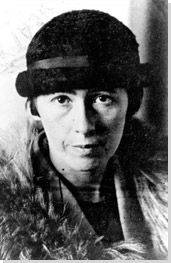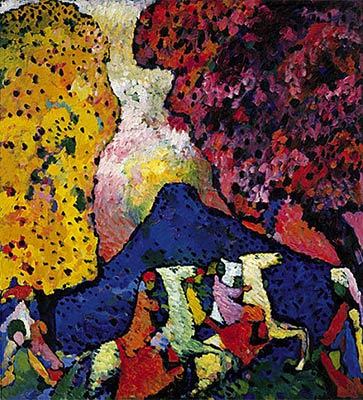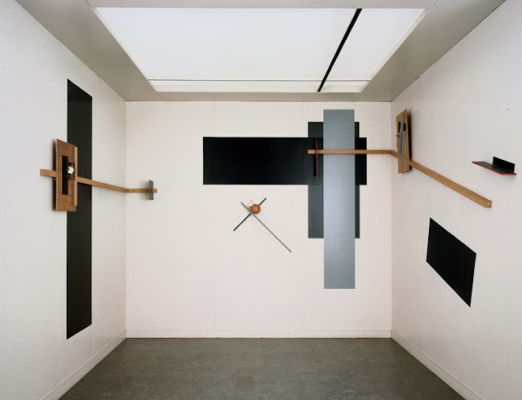Summary of Sophie Taeuber-Arp
Sophie Taeuber-Arp was a key figure in many of the important movements of the pre-World War II art scene in Europe, and was one of the most active figures around the Café Voltaire in Zurich. She dedicated her career to breaking down static, artificial boundaries between genres and forms, and celebrating the creative energy such liberation released. Her creations attempted to destabilize traditional norms in art and society, and question fixed notions of gender, class, and nationality. For Taeuber-Arp, art was both something political and something to be integrated into everyday life. She later embraced the principles of Constructivism, and became one of its most important practitioners outside of Russia. Taeuber-Arp's artworks, whether a marionette, a dancer's movement, or a textile pattern, presented the possibility of crafting a more beautiful world from the elements of the present one.
Accomplishments
- Taeuber-Arp was one of the signers of the Dada Manifesto and remained dedicated to the ideas of Dada throughout her career. She applied Dada to a wide range of forms, fully embracing the utopian impulses and promises of the movement to radically transform society by transforming human perception with radicalized aesthetics.
- Taeuber-Arp desired to break down the boundaries between applied and fine arts. She translated principles from one genre into another, creating beautiful and groundbreaking hybrids. For example, her work with Theo Van Doesburg in the Café de L'Aubette brought principles of applied textile design into the creation of architectural space and decor.
- She also explored the relationship between fine art and performance - working with dance, movement and masks. She sought to bring the ideas of Dada and Abstraction to dance and puppetry, contrasting the restriction and freedom of movement and pose, while the masks and costumes highlighted the split between dancer and the dance.
Important Art by Sophie Taeuber-Arp
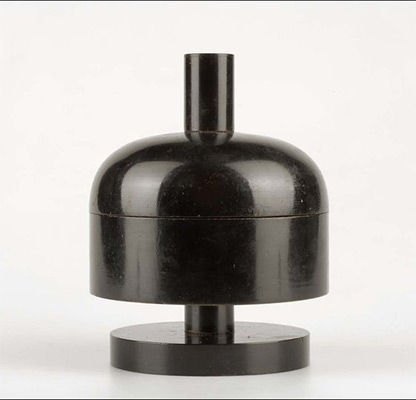
Untitled (Dada Bowl)
This almost-minimal object of turned wood shows the possibility of infusing a functional object with a radical aesthetic. Note the upturned concave shape, perhaps reflecting the Dada belief in the topsy-turvy state of the world. Taueber-Arp applied the nascent Dada strategy of attacking the bourgeois sensibilities of a corrupt world to the decorative arts. This strategy accomplished several goals. The object straddles boundaries: it is representational and abstract, made by hand and uniform as if machine-produced, utilitarian, and aesthetic. At a time when abstraction was in the vanguard and the applied and fine arts strictly divided, this combination made the object impossible to categorize. Furthermore, the sleek upturned bowl translated the simple geometric forms then in vogue in avant-garde fine art into the three-dimensions of the material world, elegantly eradicating the division between art as representation and life.
Varnished/Lacquered Wood
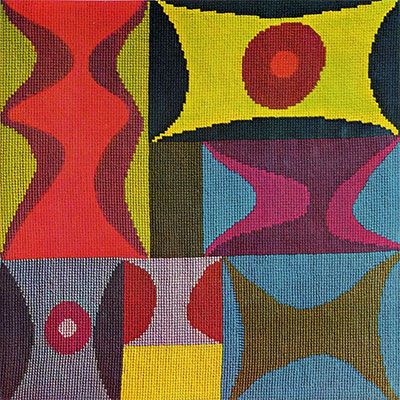
Elementary Forms
Unlike other textiles at this time, Elementary Forms was made to hang on a wall. Treating an embroidery like a painting was an innovation. Taeuber-Arp tried to erode notions about what materials could be used to create art. The obvious weft changes how the viewer sees the decorative embroidery, forcing one to consider its texture and the implication of the hand that made it. Taeuber-Arp takes radical notions of non-representational art and applies their tenets of color and form to traditional woman's work. In this avant-garde pursuit, she is unexpectedly enabled by traditional gender roles. Her position as a textile designer (a female occupation) was an asset because the applied arts were granted more freedom to pursue abstraction (patterns, decorative borders) than the fine arts were, as abstraction was contentious and often unrecognized as art. Designs such as this allowed her to demonstrate her complex understanding of color and shape. Elementary Forms is one of her earliest Constructivist works. The embroidery shows the complex intermixing of art and design that she pursued without differentiation. The title refers to the language then common in the dialogue around abstraction, which sought to connect to the eternal and fundamental building blocks of the universe.
Embroidery
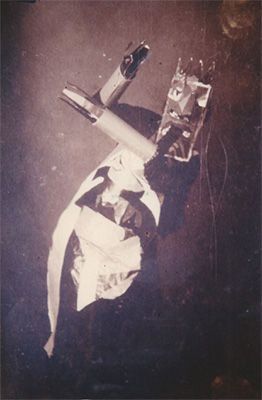
Sophie Taeuber-Arp Dancing in Costume
This photograph represents the advent of abstract dance in the 1910s. Masks were intended to free the dancer's spirit, and it has been suggested that the costume was richly colored in blue, red, white, and brown as well as silver and gold. The geometric, restrictive forms on her top half make movement ungainly, in contrast to the greater freedom of movement around her legs. Modern dance teacher von Laban had expanded Taeuber-Arp's understanding of dance to include intuitive and abstract movements. These unstructured forms broke from the common language of dance, paralleling the Dada attempt to break from established language and art forms of a flawed and broken social system. Like a noise poem, dance invoked nonsense to counter the established order. In contrast to the aspirations of eternality and monumentality of static works, dance highlights the tragi-comic aspect of Dada. Taeuber-Arp brought Dada's protest to the body dancing under the name G. Thauber. Neutered and made anonymous by the costume, her female body is an absurd protest and a live abstraction - fractured and hobbled like the broken world around her.
The photograph is the only visual evidence of Taeuber-Arp's activity as a dancer and one of the very few existing photographs of early Dada performance. Scholars debate if it was taken in 1916 at the Caberet Voltaire or in 1917 at the Galerie Dada, and who made the costume and mask. Regardless, it represents an important and prolific part of Dada activity. It has been theorized that the ambiguity of the photograph's reference - when and where it was taken - is what makes it such a fine example of Dada dancing. It is impossible to fix the meaning of the image or the figure, allowing every viewer to experience, and interpret, it for themselves.
Photograph - Stiftung Hans Arp and Sophie Tauber-Arp
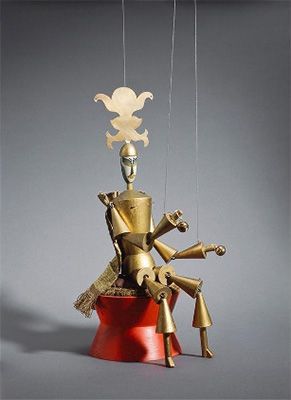
Konig Deramo (King Deramo)
Taeuber-Arp created marionettes for Alfred Altherr's Dada puppet show production of Carlo Gozzi's fairy-tale King Stag (1762). Altherr's version of Gozzi's tale satirized the 1913 split between Sigmund Freud and Carl Jung, which Taeuber captured in her dream-like designs. It was a break from tradition to use marionettes or puppets in something besides children's entertainment. Taeuber-Arp based the movements of her figures on her studies and subsequent Dada dance productions. She applied abstraction and Dada to the design of the marionettes. Taeuber also translated the elements of her textile work, the square, the circle, and the triangle, into three dimensional shapes which became the bodies of her puppets. The puppets have been described as subversive, as the inhumanity of the figurines acts as a commentary on the inhumanity of militarism and imperialism, and the absurdity of the figures reflects the absurdity of modern European culture. Other viewers felt her figures communicated a mystic truth, and their design was guided by a 'spiritual center.'
Wood, Metal, Brass (painted), and Textile - Museum Bellerive
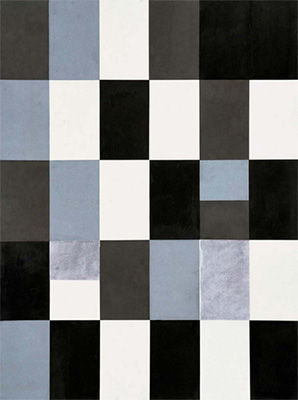
Duo-Collage
This work is one example of a set of compositions that Taeuber-Arp and her future husband Hans Arp produced from about 1916-18. These works are formally characterized by strictly vertical-horizontal geometry. They are paper squares arranged to form a precise collage - the pair even used a paper cutter to do away with any trace of the human hand. The impersonal geometric forms signified the pure, the absolute, and the infinite. Although this work is simple and private - it was never exhibited in Taeuber-Arp's lifetime - it radically upends notions of making, gender, and the meaning of art. Taeuber-Arp and Arp produced these works together so closely that is impossible to tell who made what - did Arp design and Taeuber-Arp execute? Did they make decisions together? Did they take turns? For Arp, it was radical for a man to work in a quiet medium linked to design; for Taeuber-Arp, a woman establishing herself as a textile designer, it was radical to create fine art. Yet the Duo-collages hover in-between fine and applied art - it is unclear whether the artists imagined them framed on the wall or patterning a sofa.
This fluid nature and the tensions found in vertical-horizontal compositions crop up in the artists' other works in following years. This generative, private act enabled an equal partnership at a time when even the radical rhetoric of Dada had not led to real gender equality. It escaped bourgeois commercialism and allowed them to marry their fine and applied art backgrounds. In the 1930s, Arp would claim these experiments importantly, their process removed individual egos from the creation process, thus questioning the place of the artist in artistic production and dismissing the idea of the sole genius.
Paper Collage - Nationalgalerie, Staatliche Museum, Berlin
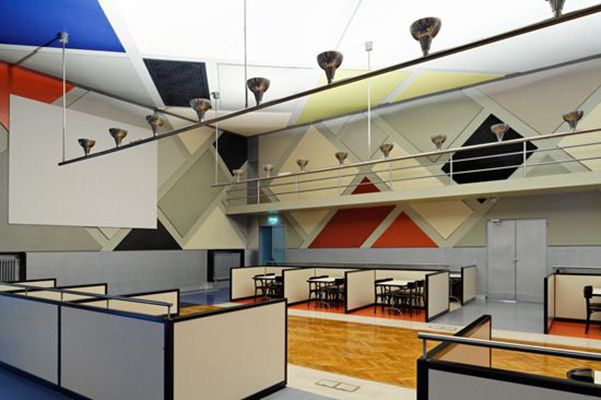
Café de L'Aubette
Taeuber-Arp was one of first intermedia artists, and here she applies a hard-edged geometric abstraction with Constructivist tendencies to interior design. Applying the visual language found in works on paper to the walls and ceilings of this leisure complex brought the Utopian ideas behind abstraction into practice to create a space of universal harmony and beauty. Taeuber-Arp collaborated with her husband Hans Arp and fellow avant-garde artist Theo van Doesburg from 1926-28. Their collaboration shared responsibility without hierarchy, just as they removed hierarchy from design of the café - for example, the tables and chairs are as important as the wall decoration. The unity of the space and strict geometry is remarkable, and greatly contrasted with interior design styles at the time. Labeled as "degenerate art" by the Nazi Party, the space was destroyed within a decade of its creation. It was the first modernist space that sought to unify form and function, predating Bauhaus. The space was called the "Sistine Chapel" of abstract art, and in 2006 was restored as shown in this photograph, at a cost of 1.34 million euros.
Café de L'Aubette - Strasbourg, France
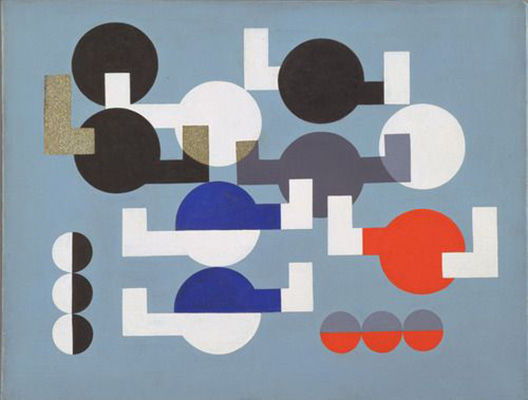
Composition of Circles and Overlapping Angles
The overlapping hard-edged geometric forms emphasize Taueber-Arp's allegiance with the Circle and Square (Cercle et Carre) group of artists, founded the same year as this painting. Circle and Square artists favored geometric abstraction over the contemporary Surrealist movement. In the image, Taeuber-Arp pursued inventive design that played form and color off each other to create tension, but at the same time integrated opposites to reflect an absolute harmony. This composition displays the aspiring purity of the Constructivist mode that sought the absolute and the non-human through geometric forms. The complex interplay of basic colors balances a series of oppositional composition choices: black and white, circle and square, red and blue. Far from static, however, these forms hover and interact in a dynamic equilibrium. This painting shows how Taeuber-Arp worked in the traditional art mediums as well as less traditional mediums, and how she translated compositional principles such as the vertical-horizontal application of the grid in applied arts to painting.
Oil on canvas - The Museum of Modern Art, New York
Biography of Sophie Taeuber-Arp
Childhood
Sophie Henriette Gertrude Taeuber was the fifth child in a middle-class Prussian family. Her father, Emil Taeuber, was a pharmacist who died of tuberculosis when Taeuber-Arp was still a child. Her mother, Sophie Taeuber-Krusi, opened a Bed and Breakfast in Trogen, Switzerland to support the family.
Early Training
Taeuber studied drawing at the School of Applied Arts in Saint Gallen, Switzerland from 1908 to 1910, but desired exposure to a wider range of ideas, and headed to Germany to study textile design. In Germany, her schooling reflected her interest in diverse fields and her unhappiness with strict boundaries and programs, as she bounced back and forth between the Teaching and Experimental Studio for Applied and Liberal Arts in Munich and the School of Applied Arts in Hamburg. She studied not only design, but also dance, weaving, and bead work from 1911 to 1913.
Mature Period
By 1915, she had returned to Zurich where her sister lived. She began to create non-representational paintings and sculptures, influenced by her training in textile design and Cubism. At the same time, she continued her work in the applied arts and her study of modern dance. The French artist and poet Hans Arp had taken refuge in Switzerland because of the First World War, and the two met in the fall of 1915. They began collaborating on artistic works, and romance followed. Her life at this time consisted of three interwoven strands: Dada as a social circle and fine art production, a career in the applied arts, and the study of modern dance.
Taeuber-Arp was active in Dada's Zurich heyday from 1916-19. Switzerland had remained neutral during World War I, and attracted an international crowd of dissatisfied or refugee artists, with whom Taeuber-Arp socialized. Her participation in Dada took many forms including dancing in avant-garde performances at the Cabaret Voltaire, an important locus of Zurich's Dada scene. Cabaret Voltaire, founded by Hugo Ball and Emmy Hennings, featured radically experimental poetry, and visual arts. Taeuber-Arp designed costumes sets, and even puppets for Dada performances. Her dances at Cabaret Voltaire incorporated radical Modernist principles of expressive movement. She collaborated with other Dada artists, especially her future husband Hans Arp, producing shows, dances, writings, and fine art works. In 1918, she was a co-signer of the Zurich Dada Manifesto.
Starting 1916, Taeuber-Arp was also a professor of textile design and technique (a department she helped found) at the Zurich School of Arts and Crafts. She wanted to establish herself as a forward-thinker in the applied arts community and joined the Swiss Werkbund, a professional association dedicated to promoting applied artists. Taeuber-Arp produced objects for use such as bead-work purses and embroidered pillowcases. Her work received critical acclaim and sold well. In February 1916, Zurich's Museum of Arts and Crafts exhibited a collection of her applied art works. Not only were critics enthusiastic, but sales were brisk enough to necessitate hiring help to execute her designs and expedite production. Because the School of Arts and Crafts did not want their professors to take part in Dada activities, Taeuber-Arp had to keep her involvement in the Dada world of Cabaret Voltaire, and later Galerie Dada, a secret. She performed in masks and under false names. This dual life ended when she felt financially comfortable enough to resign from the Zurich School of Arts and Crafts in 1928/1929.
Taeuber-Arp began studying dance with the Swiss Modern dance choreographer Rudolf von Laban in 1916 at the Laban School of Dance in Zurich. She joined the artist colony of Monte Verita in Ascona, a famous Christian-Communist community, in the summer of 1916. She returned in 1917 to participate in the Sun Festival, with the modern dance pioneer Mary Wigman. Laban considered movement a universal language, that connected all living things, reflecting similar ideas in abstraction in art. In his classes and through her friendship with Wigman, Taeuber-Arp learned to use dance as a space of intuitive movement and radically spatialized form.
On October 20, 1922, Taeuber married Arp and changed her last name to Taeuber-Arp. The 1920s was a period of frequent travel for the couple. Her vacations with Hans Arp included other friends from the Dada circle such as Tristan Tzara, Max Ernst, and Hannah Höch. The couple associated with an international circle of vanguard artists such as Francis Picabia, Lajos Kassak, and Kurt Schwitters. Notably, in 1926, Taeuber-Arp and her husband began working on a commission to design the interior of Café de l'Aubette in Strasbourg, France. They worked with Dutch artist and co-founder of De Stijl movement Theo van Doesburg to create an interior space like a Constructivist composition writ large on walls and ceilings.
After World War I, many of the couple's acquaintances had moved to Paris, then a center of the avant-garde. In 1928, Taeuber-Arp and her husband moved to Meudon, about 5 miles south of Paris, where they would live until 1940. Taeuber-Arp was at a high point of her career in terms of organizing, writing about, and exhibiting her abstract, multi-disciplinary art. She and Hans joined the Circle and Square (Cercle et Carre) group in 1930 and then the Abstract-Création group in 1931. Her work was included in the important Circle and Square exhibition at the Galeries 23 in Paris in 1930. Taeuber-Arp was the founder and editor of the Constructivist art journal Plastique (1937-39), which kept her in touch with important avant-garde figures. From the 1930s until her untimely death, she created a series of line pictures and wooden reliefs that continued to explore her long-standing interest in geometric abstraction as well as working in other mediums.
Later Period
Taeuber-Arp and her husband fled to southern France when the Nazis invaded Paris in 1940. There they created a short-lived artist's colony with Sonia Delaunay. In late 1942, the couple returned to Zurich. They attempted to obtain passage to the United States, but before they succeeded, Taeuber-Arp died in her sleep on January 13, 1943. The cause was carbon monoxide poisoning from a faulty gas stove.
The Legacy of Sophie Taeuber-Arp
To this day, Taeuber-Arp is not as well-known as other artists in her circle, including her husband Hans Arp, despite her deep involvement with the burgeoning European avant-garde and the presence of her works in museum collections across the world. Probable reasons for this lesser reputation include her being a woman, her work with craft and design - traditionally deemed lesser arts, and her premature death. However, this reputation is changing, as evidenced by the 1981 retrospective at the Museum of Modern Art in New York that subsequently traveled to Chicago, Houston, and Montreal. Her work is now generally accepted as part of the story of modernism and Dada, and has drawn increasing attention from scholars and academics. Her work was influential to the growth of Feminist Art of the 1960's, who viewed her as a trailblazer. Artists and theorists working in post-Marxism and Critical Theory have also been influenced by her work and ideas. In 1995, The Swiss government redesigned their 50 Swiss franc note to include her portrait.
Influences and Connections

-
![Dada]() Dada
Dada -
![Constructivism]() Constructivism
Constructivism -
![Cubism]() Cubism
Cubism -
![Futurism]() Futurism
Futurism ![Geometric Abstraction]() Geometric Abstraction
Geometric Abstraction
-
![László Moholy-Nagy]() László Moholy-Nagy
László Moholy-Nagy -
![Francis Picabia]() Francis Picabia
Francis Picabia -
![Marcel Janco]() Marcel Janco
Marcel Janco -
![Sonia Delaunay]() Sonia Delaunay
Sonia Delaunay ![Richard Huelsenbeck]() Richard Huelsenbeck
Richard Huelsenbeck
-
![Bauhaus]() Bauhaus
Bauhaus -
![Constructivism]() Constructivism
Constructivism ![Geometric Abstraction]() Geometric Abstraction
Geometric Abstraction
Useful Resources on Sophie Taeuber-Arp
- Sophie Taeuber-ArpOur PickBy Carolyn Lanchner
- The Dada Painters and Poets: An AnthologyBy Robert Motherwell
- DadaBy Rudolf Kuenzli
- Inventing Abstraction 1910-1925: How a Radical Idea Changed Modern ArtBy Matthew Affron, Leah Dickerman
- Intimate Collaborations: Kandinsky and Munter, Arp and TaeuberOur PickBy Bibiana Obler
 Ask The Art Story AI
Ask The Art Story AI